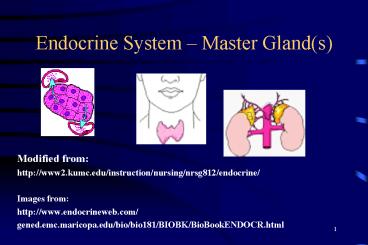Endocrine System Master Glands - PowerPoint PPT Presentation
1 / 11
Title:
Endocrine System Master Glands
Description:
Pituitary has direct neural and blood connection to the hypothalamus ... Gland is located at the base of the skull in an indentation of the sphenoid bone. ... – PowerPoint PPT presentation
Number of Views:666
Avg rating:3.0/5.0
Title: Endocrine System Master Glands
1
Endocrine System Master Gland(s)
- Modified from
- http//www2.kumc.edu/instruction/nursing/nrsg812/e
ndocrine/ - Images from
- http//www.endocrineweb.com/
- gened.emc.maricopa.edu/bio/bio181/BIOBK/BioBookEND
OCR.html
2
Hypothalamus and Pituitary
- Pituitary has direct neural and blood connection
to the hypothalamus - Hypothalamus sends releasing factors to anterior
pituitary - Hypothalamus stimulates posterior pituitary via
neural pathway
3
Hypothalamus
- Hypothalamus can synthesize and release hormones
from its axon terminals into the blood
circulation. - controls pituitary function and thus has an
important, indirect influence on the other glands
of the endocrine system. - exerts direct control over both the anterior and
posterior portions of the pituitary gland. - regulates pituitary activity through two
pathways a neural pathway and a portal venous
pathway.
4
Hypothalamus
- Neural pathways extend from the hypothalamus to
the posterior pituitary lobe, where the hormones
are stored and secreted. - Portal venous pathways connect the hypothalamus
to the anterior pituitary lobe, carry releasing
and inhibiting hormones
5
Pituitary Gland
- Pituitary Gland is located at the base of the
skull in an indentation of the sphenoid bone. - Is joined to the hypothalamus by the pituitary
stalk (neurohypophyseal tract) and consists of
the anterior pituitary and the posterior pituitary
6
Anterior pituitary gland (adenohypophysis)
- Called the master gland, because its anterior
lobe has direct control over the secretion of - ADH - antidiuretic hormone (vasopressin)
- ACTH - adrenocorticotrophic hormone
- TTH - thyrotrophic hormone
- GH - growth hormone
- FSH - follicle stimulating hormone
- LH - leutinizing hormone
7
Posterior pituitary
- Stores and secretes hormones made in the
hypothalamus and contains many nerve fibers. - ADH (Antidiuretic Hormone/Vasopressin), which
controls the rate of water excretion into the
urine - Regulates Na K reabsorption in the kidneys
this influences blood volume blood pressure - Oxytocin, which, among other functions, helps
deliver milk from the glands of the breast.
8
(No Transcript)
9
Steroid Hormones
- Diffuse into cell and influence DNA
- Bind to a protein associated with DNA
- Cause DNA to increase synthesis of specific amino
acids
10
Feedback Loops
- The release of a hormone is often triggered by a
change in the concentration of some substance in
the body fluids. - Each hormone has a corrective effect, eliminating
the stimulus, which then leads to a reduction in
hormone secretion. - This process is called a negative feedback
homeostatic control system to keep hormones at
normal levels. (if levels increased it would be
called positive feedback)
11
Sources
- http//www.letsfindout.com/subjects/body/
- http//www.endocrineweb.com/whatisendo.html
- http//www.stmarys.medford.or.us/curriculum/bio/hb
sm/glands/katie.htm - http//www2.kumc.edu/instruction/nursing/nrsg812/e
ndocrine/ - http//gened.emc.maricopa.edu/bio/bio181/BIOBK/Bio
BookENDOCR.html - http//www.novo-nordisk.co.uk/health/dwk/info/ency
clopedia/1/3.asp

